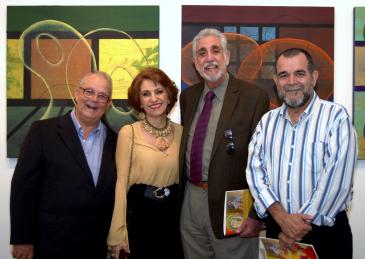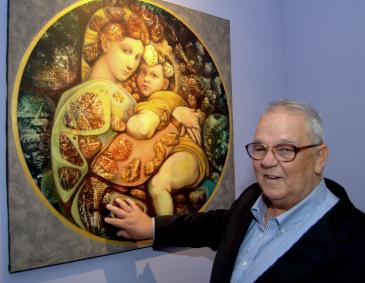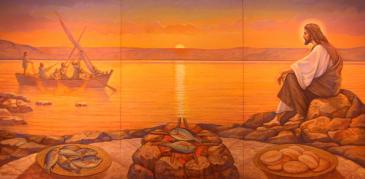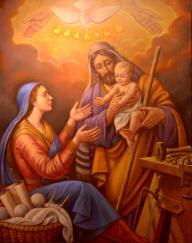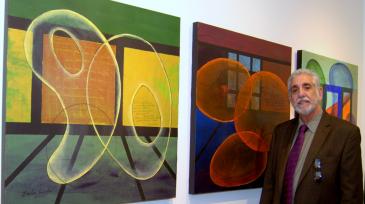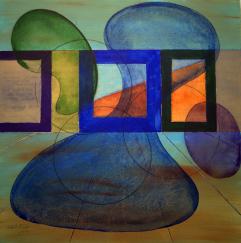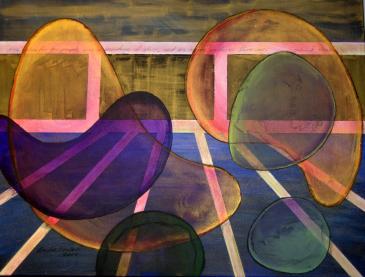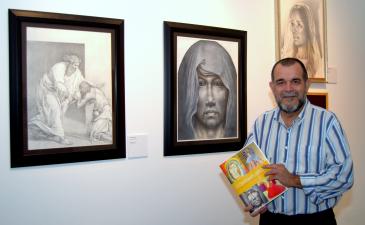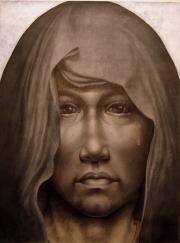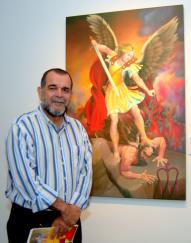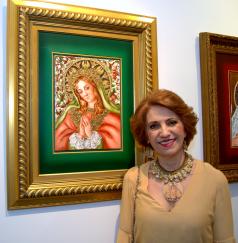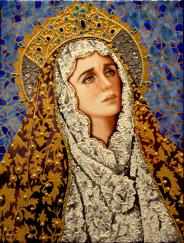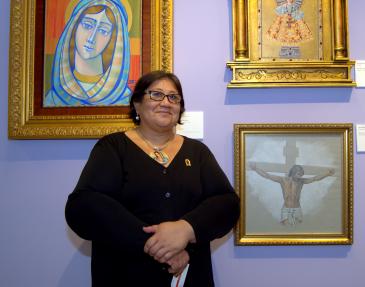By Jim Davis - Florida Catholic
Photography: JIM DAVIS | FC
MIAMI GARDENS | Catholic art is alive and well, states Isabel Medina — and she says she can prove it, 25 times.
That's the number of artworks in "Contemplations," the new exhibition she has put together at St. Thomas University. The exhibition shows the works of four artists, all born in Latin America but now residing in South Florida.
The "Michelangelos of Miami," she calls them.
"Many people look back 500 years to see religious art," said Medina, coordinator of STU's Favalora Archive and Museum, at the show's opening Nov. 7. "They don't know the incredible artworks being made in Miami."
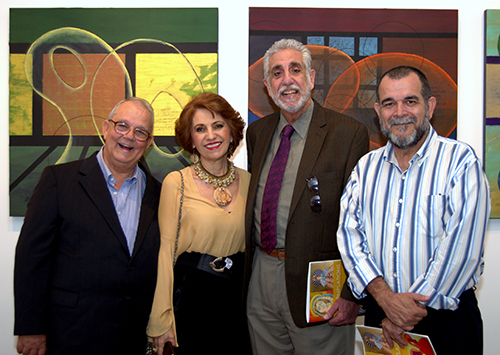
Photographer: JIM DAVIS | FC
Four artists pose for a group photo at the "Contemplations" exhibition at St. Thomas University. From left are Emilio Falero, Beatriz Ramirez, Emilio Hector Rodriguez and Hernan Miranda.
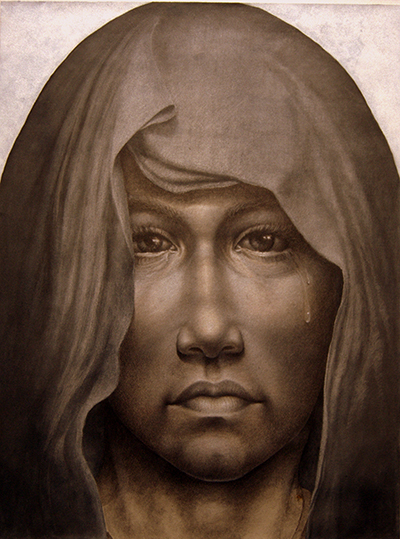
Photographer: JIM DAVIS | FC
"Regreso del Hijo Prodigo" is one of six contributions by Hernan Miranda at the "Contemplations" exhibition at St. Thomas University.
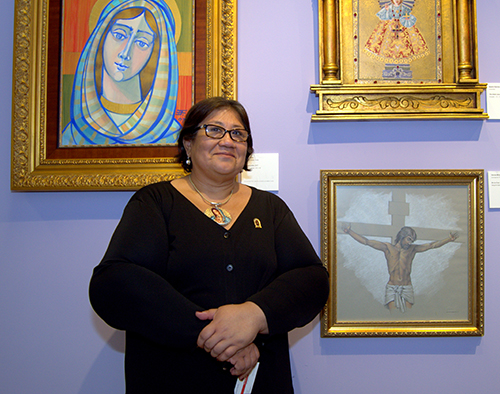
Photographer: JIM DAVIS | FC
"Catholic art is alive and well," says Isabel Medina, curator for the "Contemplations" exhibition at St. Thomas University.
The two dozen pieces actually span a longer time frame than 500 years. They include:
- Renaissance and Baroque revival paintings by Emilio Falero, who works in acrylics as well as oil paint.
- Lavishly jeweled portraits of Mary by Beatriz Ramirez, resembling eastern icons.
- Intense windows onto biblical scenes by Hernan Miranda, using the smooth shading method known as chiaroscuro.
- Organic, abstract acrylics by Emilio Hector Rodriguez, acting as foci for Bible verses.
Msgr. Franklyn Casale, STU president, said such exhibitions are a longtime part of the university tradition. He noted also that the Church has been a patron of the arts for centuries.
"And this [exhibition] is not just about what has been done before," added Msgr. Casale, who attended the opening. "It's about the creation of new art and new forms."
For Falero, one of two Cuban-Americans in the exhibition, such art shows help to counter what he sees as a "gloomy" trend in art, which he said often ignores religion or even opposes it. He said that art can even become part of the "new evangelization," as Pope Francis said in a documentary film this year.
"Art is more than a mirror of life — it's an X-ray of the soul," Falero said. "We need to counter [secular art] with life and hope. We need more reconciliation, forgiveness, dialogue."
New styles and themes were definitely on display at the STU exhibit, as the four artists said after the press conference.
Falero's six contributions to "Contemplations" come closest to traditional Catholic art. His oils and acrylics show several views of Mary, from simple to ornate. One shows her with grapes and wheat, the basics of the bread and wine of the Eucharist.
Yet Falero innovates with a surreal, mixed-media Madonna. The folds of her robe, even the waves of her hair, show textures of rock or coral, seemingly embracing the natural world as she embraces the Baby Jesus.
Ramirez, the only female artist in the exhibition, brought dazzling portraits of Mary crusted with gold, pearls, garnet and lapis lazuli. Starting with a porcelain base, Ramirez builds up her pictures in layers, firing them each time — a total of seven layers for her work "Our Lady of Sorrows."
It may sound exhausting, but not for Ramirez. "I love this technique. I've taught it around the world," she said.
Despite all the jewels and metals, she once created a series showing the coffee crops of her native Colombia. "Our Lady and Coffee Flowers," part of the STU exhibition, has Mary and Jesus crowned with coffee cherries; their very robes resemble the long, white petals of coffee blossoms.
Miranda has studied the dramatic lighting styles of the likes of Rembrandt and Caravaggio. The Paraguay native's oil and graphite pictures are rendered so smoothly, they resemble monochrome photos.
Although he held his first exhibition in 1987, in his homeland capital of Asuncion, it was four years ago that he visited Rome and became fascinated with what he found. "I discovered that religious art was exciting, and a lot of its themes are contemporary for our time," he said.
His goal nowadays is not only a visual effect, but "visual affection" — humanizing spiritual themes. "I want not just religious images, but humanized faces. I want the faces sweet and the shoes dirty."
Rodriguez's art may seem hardest to grasp: flowing, transparent blobs of color on geometric backgrounds. But look closer, and you'll see handwritten excerpts from Sirach, part of a body of Bible books known as wisdom literature.
One of the artworks carries the verse Sirach 10:14: "The thrones of the arrogant God overturns, and establishes the lowly in their stead." Another quotes Sirach 38:30: "With his hands he molds the clay, and with his feet softens it. His care is for proper coloring, and he keeps watch on the fire of his kiln."
"My art is more conceptual," said Rodriguez, who was born in the Cuban colonial village of Sancti Spiritus, then moved to Miami in 1982. "People approach a painting looking for something accessible; then they receive a message they weren't looking for. My object is not a Christian message but a message of life. Everyone can receive it — Jewish, Christian, Muslim or nonbeliever."
Julia Carlson Ricks, Medina's assistant archivist, echoed Rodriguez's hopes for the whole exhibition. "I hope people will leave saying, 'Wow! That woke up something in me!'
"This exhibition is not just for the religious. I hope people will come away with an appreciation for the beauty and power behind the pictures. That's the true meaning of the word 'Catholic': universal."
If you go
- Event: "Contemplations," art exhibition
- Featuring: 25 pieces of spiritually themed art by four Latin American artists
- Where: St. Thomas University, 16401 N.W. 37th Ave., Miami Gardens
- Where on campus: Archbishop John C. Favalora Archive and Museum, on the second floor of the university library
- Dates: Nov. 7 to Dec. 12
- Cost: Free
- Info: Isabel Medina, curator, [email protected] or 305-628-6769.

